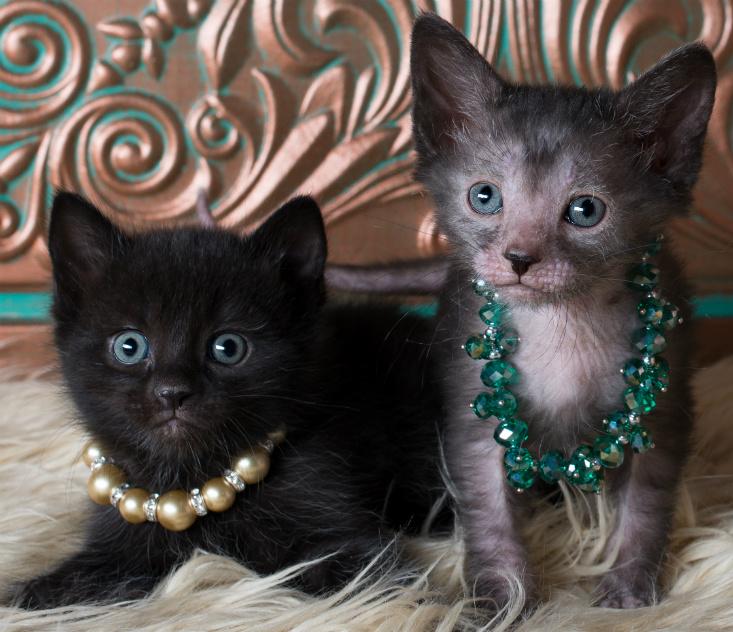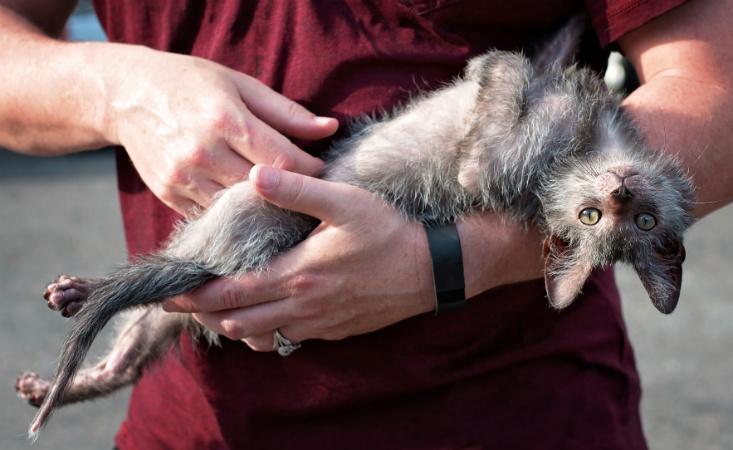
“These are the result of a natural mutation that appeared in the wild cat population,” says Johnny Gobble, a veterinarian and breeder of Lykois. “They’ve been reported for years, but no one has tried to breed them because there were concerns about their health.” Though the cats don’t project the image of a hale, hearty feline, the unusual variety has caught the interest of cat fanciers recently. This mutation for patchy hair—reviled in domestic cats and quickly weeded out of wild-cat populations—could soon experience an unprecedented boom, as the trademark of a popular new breed.
The Lykoi’s partially furred faces and paws are the source of their fame as well as their name. Lykoi is derived from the word “lycanthrope,” alluding to the animal’s resemblance to creatures like Lon Chaney’s iconic Wolfman. And like their namesake, hair comes and goes for Lykoi cats. The kittens are born nearly naked and later spend parts of their adulthood that way, occasionally molting much of their sparse fur. Coincidentally, the breed seems doglike in its behavior as well. “They can be very in-your-face,” Gobble says, from his farm outside of Knoxville. “They like to follow you around and see what you’re doing.”
According to Gobble, the cats’ infirm appearance is only skin deep. Aside from the patchy hair that makes them notable, the first few generations of Lykoi cats seem rather healthy thus far. Tests conducted by Leslie Lyons, an aptly named expert in cat genetics at the University of Missouri (home of The Tigers), found no recognized genetic disorders in the cats; a battery of tests done by Gobble at his clinic, from blood screenings to thyroid function exams, turned up nothing out of the ordinary. Gobble cautions, though, that giving the breed an entirely clean bill of health right now would be premature. “It’s way too early,” he emphasized. “A lot of health problems won’t show up until a cat is 6 or 7 years old, and we don’t have any Lykois that old yet.”
There is some reason to think the breed’s unusual look may contribute to health problems. Their spare coats cause oils to build up on their skin, especially around their ears and toes. In similarly hairless Sphynx cats, the buildup can result in a vulnerability to ear infections and mite infestations if not monitored closely. The thin coats also make the animals susceptible to cold, explaining why the mutation that produces Lykoi cats is fairly rare in feral cat populations: Presumably, most naturally occurring specimens freeze to death in cold weather before they can pass it along. If Lykois are not housed inside, they’ll need access to a heater to survive cold winters.
Of course, it’s not always health that humans are seeking in a new animal breed—often, it’s novelty. Breeders look for very specific traits and do their level best to not only bring them out but hone them to their ultimate expression. Pug noses get flatter, corgi legs shorter, and bulldog shoulders so broad that the animals have to be delivered by cesarean section. Rather than being weeded out as they are in nature, these mutations in breeding are prized, preserved, emphasized, and multiplied at grand scales. At its heart, breeding animals represents the industrialization of mutations.
This process is sometimes handled by breeders who treat animals as raw materials to be exploited. While many breeders are responsible stewards of the animals they sell, there seems to be a never-ending string of reports about “puppy mills”: breeding facilities where dogs are housed in inhumane and filthy conditions, without access to proper veterinary care and socialization. Puppy-mill dogs are often killed once their best breeding years have passed.
Even when breeding is handled more responsibly, the very traits that breeders select for are often detrimental to the health of the animals that carry them; heavily bred animals tend to suffer for fashion. The short legs that corgi owners find so endearing are symptoms of the breed’s achondroplastic dwarfism. This genetic condition interrupts proper formation of cartilage and skeletal bone, and is associated with the corgi propensity for developing osteoarthritis and ruptured vertebrae. The mutant gene that gives shar peis their distinctive skin wrinkles is also associated with the periodic fevers common in the breed. In cats, the Scottish Fold’s “folded over” ears come from a mutation that hinders cartilage and bone development, which leads to serious, sometimes crippling, arthritis and bone deformities.
While we don’t know exactly what gene is responsible for the Lykoi’s unique aesthetic, it seems the gene is recessive, based on the way it’s inherited (or not) by the offspring of Lykois. Unfortunately, that makes breeding for the trait something of a crapshoot. Gobble, and the few other breeders working with him to develop the Lykois, breed cats expressing the mutation to standard black shorthairs, resulting in a litter of plain-looking black cats that each carry one Lykoi gene. (Because the trait is recessive, it only manifests if the cat carries two Lykoi genes.)

The only sure way to get a litter of Lykoi kittens is to breed one Lykoi to another, and currently there are only 19 cats in the world that qualify as standard. The soonest Gobble expects any more Lykoi kittens is two years from now, when the Lykoi will have been bred to black domestics for five generations, hopefully resulting in enough standard Lykois to begin displaying the breed in shows.
As to the fate of the cats that result from breeding attempts but don’t have that Lykoi look, Gobble assures me that the breeders find homes for the cats that don’t carry the Lykoi gene. Though they don’t get the Lykoi coat, the kittens do seem to inherit the breed’s gregarious nature, and all are registered with The International Cat Association, making them more attractive to people looking for a pet.
Genetic testing could pinpoint the gene responsible for the Lykoi coat, and Lyons, the feline-genetic expert, is working on finding it. One potential culprit, the gene that is responsible for the completely hairless Sphynx cat, has already been eliminated. For his part, though, Gobble is more interested in the practical expression of the Lykoi gene than hunting down the series of base pairs that is ultimately responsible for it. For now, Gobble and his colleagues are working on bringing new Lykois into the breeding program and avoiding the inbreeding that can compound the health problems of purebred animals.
That’s not a simple matter. Humans have been manipulating animal mating for eons, but it’s by no means a primitive task. Breeding is, in one view, a years-long assembly line for turning out increasingly finely tuned products. As in any complex production process, care and attention are required to prevent defects. In breeding animals to be larger or smaller, faster or stronger, hairier or balder, humans manipulate the stuff of life itself, but we are never able to fully control the devilishly complex processes that have evolved over billions of years.
Ian Chant is a science and technology journalist and an editor at IEEE Spectrum. His pedigree questionable at best.
source
No comments:
Post a Comment